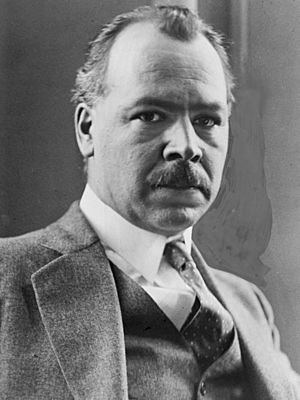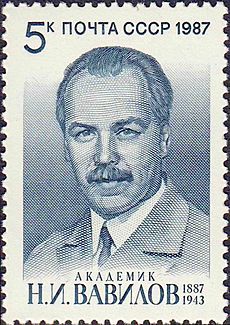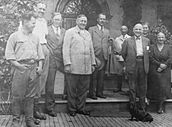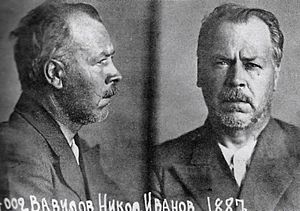Nikolai Vavilov facts for kids
Nikolai Ivanovich Vavilov (Russian: Никола́й Ива́нович Вави́лов; 25 November 1887 – 26 January 1943) was a famous Russian and Soviet scientist. He was an agronomist (someone who studies soil and crops), a botanist (plant scientist), and a geneticist (someone who studies how traits are passed down).
Vavilov discovered the "centers of origin" for many cultivated plants. This means he found the places in the world where important food crops like wheat and maize (corn) first grew. He spent his life studying and improving these crops to help feed people around the world.
Sadly, Vavilov's work was criticized by another scientist named Trofim Lysenko. Lysenko's ideas about plants were different from Vavilov's and were favored by the leader of the Soviet Union, Joseph Stalin. Because of this, Vavilov was arrested and later died in prison in 1943. After Stalin's death, Vavilov's name was cleared, and he became known as a hero of Soviet science.
Contents
Early Life and Learning
Nikolai Vavilov was born in Moscow into a family of merchants. He was the older brother of the famous physicist Sergey Ivanovich Vavilov. Even though he grew up in a strict religious family, he became an atheist.
His father had experienced poverty and famine (extreme hunger) when he was young. This made Vavilov determined from a young age to find ways to end hunger for everyone.
In 1906, Vavilov started studying at the Petrovskaya Agricultural Academy. He was known for carrying a pet lizard in his pocket! He finished his studies in 1910, writing about snails as pests (animals that harm crops).
After graduating, he worked in different plant science departments. From 1913 to 1914, he traveled in Europe. He studied how plants become immune (resistant) to diseases. He even worked with a British biologist named William Bateson, who helped start the science of genetics.
Academic Work and Discoveries
From 1917 to 1920, Vavilov was a professor at the University of Saratov. Later, from 1924 to 1935, he led the Lenin All-Union Academy of Agricultural Sciences in Leningrad.
He was very impressed by the work of a Canadian plant scientist, Margaret Newton. She studied a wheat disease called stem rust. In 1930, Vavilov tried to hire her to work at his institute, offering a great salary. She didn't accept the job, but she did visit the institute in 1933. She spent three months training 50 students in her research methods.
Vavilov developed his important idea about the "centers of origin" for cultivated plants. To do this, he went on many expeditions around the world. He collected seeds from almost every country. In 1927, he shared his findings at a big genetics conference in Berlin.
In Leningrad, he built the world's largest collection of plant seeds. Vavilov also came up with the "law of homologous series in variation." This law explains how similar genetic changes can happen in related plant species. He was also a member of the USSR Central Executive Committee and won the Lenin Prize.
Challenges and Persecution
In 1932, Vavilov suggested that the next big International Congress of Genetics should be held in the Soviet Union. After some discussion, it was agreed that the congress would take place in Moscow in 1937. Vavilov was chosen to lead the event.
However, in 1936, the Soviet government decided to cancel the congress. The meeting was moved to Edinburgh, Scotland, in 1939. Vavilov was not allowed to travel abroad. At the opening ceremony, an empty chair was placed on the stage to show that he was sadly missing.
Vavilov first supported a young scientist named Trofim Lysenko. But Vavilov soon realized that Lysenko's ideas about genetics were wrong. Vavilov worried that Lysenko's theories would be very bad for Soviet agriculture. He openly criticized Lysenko both in his home country and when he traveled abroad.
However, Joseph Stalin, the leader of the Soviet Union, believed in Lysenko's theories. Because of this, the rest of the Soviet government also supported Lysenko. The authorities began to suspect that Vavilov was trying to harm Soviet agriculture with his "bad science." Their suspicions grew because Vavilov knew other scientists who had been accused of spying. Some of these scientists wrongly said that Vavilov was involved in anti-government activities.
As a result, Vavilov was arrested on 6 August 1940 while on an expedition in Ukraine. He was accused of spying for other countries and trying to sabotage Soviet farming.
In July 1941, he was sentenced to death. But in 1942, his sentence was changed to twenty years in prison. In 1943, he died in prison because of the very difficult conditions. Records show he had lung problems and was very weak. Some people believe he died from starvation.
Family Life
Vavilov had a son named Oleg with his first wife, Yekaterina Sakharova, in 1918. They divorced in 1926. Later, he married another geneticist named Elena Ivanovna Barulina. She was an expert on lentils and helped manage the institute's seed collection. Their son, Yuri, was born in 1928.
After His Death
In 1955, Vavilov's prison sentence was officially canceled. This was part of an effort to review old cases from the Stalin era. By the 1960s, his good name was restored, and he was celebrated as a hero of Soviet science.
Vavilov's Lasting Impact
The seedbank in Leningrad, which Vavilov helped create, was incredibly important during the 28-month-long Siege of Leningrad. Even though the city was starving, the scientists at the Vavilov Institute protected the 250,000 samples of seeds, roots, and fruits. This was the world's largest seedbank at the time. The scientists refused to eat the seeds, even though many of them died of starvation by the end of the siege in 1944.
During World War II, some of Vavilov's collection in German-occupied areas like Ukraine and Crimea was taken by a German unit. Many samples were moved to a German plant genetics institute in Austria.
The Royal Society of Edinburgh incorrectly states that Vavilov died in a Soviet work camp in Siberia. He actually died in a Soviet prison in Saratov.
Things Named After Vavilov
Today, a street in downtown Saratov is named after Vavilov. A monument to him was put up in Saratov in 1997. Another monument is near the Resurrection cemetery in Saratov, where he is buried. The USSR Academy of Sciences created the Vavilov Award (1965) and the Vavilov Medal (1968) to honor him.
The N.I. Vavilov Institute of Plant Industry in St. Petersburg still holds one of the world's largest collections of plant genetic material. Vavilov led this institute from 1921 to 1940. In 1968, it was renamed after him.
A minor planet (a small space object) called 2862 Vavilov was discovered in 1977. It is named after Nikolai and his brother Sergey. A crater on the far side of the Moon is also named Vavilov after both brothers.
Media About Vavilov
- The story of the scientists at the Vavilov Institute during the Siege of Leningrad inspired the 2003 novel Hunger by Elise Blackwell.
- This novel also inspired the Decemberists' song "When The War Came" from their 2006 album The Crane Wife. The song mentions the Institute and Vavilov.
- In 1987, a film called Star of Vavilov (Russian: "Звезда Вавилова") was made about his work.
- A six-part documentary series titled Nikolai Vavilov was made in 1990 by the USSR and East Germany.
- Season 1, Episode 4 of the 2020 science documentary series, Cosmos: Possible Worlds, was called "Vavilov." It told the story of his life and work.
Works by Vavilov
- Agricultural Afghanistan (1929)
- Breeding as science (1934)
- The law of homology series in genetical mutability (1935)
- The theory of origins of cultivated plants after Darwin (1940)
- The Geographical Localization of Wheat Genes on the Earth (1929)
Works in English
- The Origin, Variation, Immunity and Breeding of Cultivated Plants (1951)
- Origin and Geography of Cultivated Plants (1987)
- Five Continents (1997)
See also
 In Spanish: Nikolái Vavílov para niños
In Spanish: Nikolái Vavílov para niños
- VASKhNIL (the All-Union Academy of Agricultural Sciences of the Soviet Union)
- All-Russian Institute of Plant Industry
- Vavilovian mimicry
- Vavilov Center
- Lysenkoism





